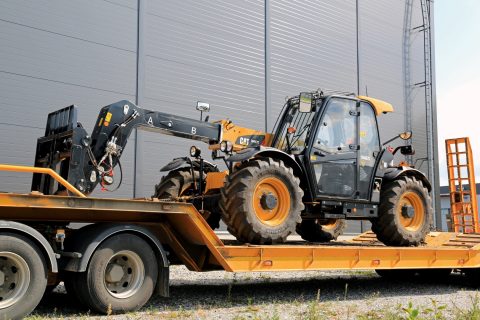Trailers can be used in various ways. For instance, businesses can use them to transport goods and equipment. They can also be used for storing materials, tools, and equipment. Whether for commercial, personal, or industrial purposes, a trailer deck should be ideally sturdy enough to withstand heavy loads.
This comprehensive trailer decking guide will help you understand how to choose from various types of decks available in the market when planning and how they can be installed. It will also provide information on maintaining them properly so they last longer.
What Is A Trailer Deck?
A trailer deck is basically a platform that supports cargo. It is attached to the vehicle using a hitch, allowing it to move with it. While the primary purpose of this type of deck is to carry cargo, some people use them for other purposes, such as additional storage space.
Before learning about trailer deck installation or heading straight to get trailer decking supplies & services, you must first understand the types and materials available so you can choose which decking is best for your trailer needs.
Some of the most common types of trailer decks include:
- Flatbeds
The design of these decks allows for easy loading and unloading of cargo. They have no sides or roof, making them ideal for carrying large items like furniture or industrial materials.
- Drop Deck
Also known as a step deck trailer, this allows for more flexibility than flatbeds. This type also has no walls or roof and is lowered onto the ground using a step. It has a ramp at one end, which helps load and unload cargo.
- Double-Drop Deck
Similar to drop decks, a double-drop deck also has two levels. It has a long main deck, often referred to as the well. It has a lower ground clearance and would be ideal for heavy and high hauls.
Trailer Decking Materials To Choose From

Like trailer types, there are also various options of decking materials available for building trailer decks. As they carry heavy loads, you may want to opt for materials that are durable, strong, can last long, and offer low maintenance.
Furthermore, the choice of flooring material may depend on the type of trailer you have and what you intend to use it for. Here are some of the most popular options:
- Wood
Wood is perhaps one of the most used decking materials in the market. It’s durable and can be long-lasting. This material is most commonly used for commercial purposes, such as moving companies and livestock.
- Steel
Steel is another type of flooring commonly used in trailer decks. While it is known for its durability, one of its disadvantages is it can be highly prone to rust. As such, it may need regular maintenance to prevent rusting.
- Aluminum
If you’re looking for a lightweight option, aluminum might be the right material for you. It can be perfect for your trailer as it is rust-resistant. However, aluminum can be expensive and may not be ideal for hauling equipment.
- Rubber
Rubber flooring is highly durable. It can withstand heavy equipment and extreme weather conditions. It is also easy to maintain and is slip and chemical resistant.
How Do You Choose A Trailer Deck?
When choosing a trailer decking, there are several factors that you should consider. Some of these include:
- Size
If you plan to transport bulky equipment, you may opt for a larger deck. But if you’re looking to haul light items, you might want to go for a smaller deck.
- Durability
As mentioned earlier, a good trailer deck should be able to support its function and intended purpose, withstand heavy loads and pressure, and can last for a long period.
- Cost
Cost may generally vary depending on the type, size, and material. In addition to the initial expense, it is also worth noting the possible costs of maintaining them in the future.
- Installation
Another thing to factor in is the ease of installation. There are many ways to install, and one way is to attach them directly to your car’s frame. Another option is to latch it onto the vehicle using bolts, yet another method involves the use of chains.
- Maintenance
After installation, you need to maintain your trailer decking regularly. The most common problem with trailer decks is rust in steel or termites and rot in wood. Aside from the maintenance cost, you must also consider if the trailer needs high maintenance or not.
Installing A Trailer Deck
After carefully planning and deciding what kind of decking material you want for your vehicle, you can start installing it. Here are some tips on how to install a trailer deck:
1. Measure The Trailer
It’s essential to measure your trailer before you begin so you don’t waste time and money on materials you’ll only discard or never use. You can start by taking notes of its dimensions.
2. Use Proper Tools
You should always use proper tools and equipment when working on your vehicle. Doing so can ensure safety and efficiency. When installing a trailer deck, consider preparing the following:
- A jack for lifting the vehicle
- A hammer for pounding nails
- A screwdriver for tightening screws
- Wrench for loosening screws
On that note, ensure that you use the correct screws and fasteners. For instance, if you want screws that are stronger and can last longer, you can use lag screws.
3. Cut The Material
Once you have measured your vehicle, you can cut the material needed for the deck accordingly. When cutting, try to keep the edges straight and smooth and not leave any sharp corners. Also, you may want to ensure that the cuts are even and that there are no gaps.
4. Ensure That Your Vehicle Is Level
Leveling your vehicle ensures the trailer can sit evenly on top without tipping over. To achieve this, you can use a spirit or bubble level. It generally works by gauging the angle between two points. Once you know the center of gravity, you can adjust the height until the vehicle is perfectly level.
5. Attach The Decking Material
You can easily attach the deck to the vehicle using bolts, screws, or other fasteners. Before doing so, ensure that the holes are aligned with the holes in the vehicle and tighten them down securely.
When attaching the decking, apply enough pressure to secure the deck firmly, so you don’t overtighten the bolts. Note that overtightening the bolts may cause damage to the vehicle.
6. Sand Down Any Rough Edges
If you notice rough edges after attaching the deck, you can sand those down. Doing this can help give the deck a smoother look. You may use different kinds of sandpaper depending on the texture of the surface.
For example, if the surface has a lot of small bumps and needs a lot of smoothing, you can use coarse-grit sandpaper. If the surface seems flat enough, you can use fine-grit sandpaper instead.
7. Clean It Up
You can finish the installation process by cleaning it up. Thoroughly cleaning the area removes dirt and grime from the surface. Depending on the material, you can coat the entire area with primer after cleaning. You can even finish it off with a coat of paint. With that, consider using quality paints that can last for years.
Keeping Your Trailer Deck In Good Shape
Trailer decks need maintenance just like any other part of your vehicle. Here are some tips to help you maintain your trailer deck properly:
1. Keep Your Trailer Deck Clean
Keeping your trailer decking clean is essential because dirty surfaces attract dust and debris. When they accumulate, they can be hard to remove and may even cause growths of mold or corrosion, depending on the material.
When cleaning your trailer deck, first sweep away all loose debris. Then, you can wash the floor with soap and water. Use a sponge or rag to scrub the surface or spray it with a hose attachment. Finally, rinse the area well and dry it thoroughly.
If snow or ice accumulates on your trailer deck, you must clear it off periodically. Otherwise, it can freeze and become dangerous.
2. Maintain Proper Tire Pressure
Tires play an important role in keeping your trailer deck safe and stable. Inspect whether the tires are inflated correctly to provide adequate support for the trailer’s weight. Ideally, you should check tire pressures at least once every month.
3. Store The Deck Safely
Make sure that you store your trailer deck safely. Don’t leave it exposed to extreme temperatures or direct sunlight. Also, avoid storing it near heat sources such as radiators or hot air vents. Exposure to excessive heat can weaken the structural integrity of your trailer deck. As such, you may cover it with shade cloth or tarp.
4. Check For Signs Of Damage
Finally, you must always keep an eye out for signs of damage. Look for dents, scratches, and other indications of wear and tear, which could tell if something is wrong with your trailer deck. Contact a professional trailer maintenance service provider if you find any issues you can’t fix on your own.
Final Thoughts
Trailer decking can be a good investment. However, like every investment, it requires thorough planning, installation, care, and maintenance. Using this guide, you can be guaranteed to get the best out of your trailer deck and stay in top shape, maximizing its lifespan.

